How Starbucks’ Own Coffee Revolution is Leaving the Chain Behind
If you’re a coffee drinker, you probably fall into (or hover between) three different camps: the drip coffee loyalists, Starbucks junkies, and a newer brand of coffee snob who seeks out the finest beans and brewing methods. Whereas drip coffee drinkers are perfectly happy with a daily dose of Folger’s or even the stuff of gas stations, the Starbucks crowd demands a frothier, sweeter fix. The last lot, sometimes called the “third wave” of coffee culture, denounces both as bastardized excuses for java.
Coffee snobs revel in an ever-changing landscape of single-origin beans and brewing technology, and shops have been cropping up around the world catering to their heightened taste. These cafés are strikingly similar in their gritty, minimalist atmospheres and menu offerings, and they’re popular with urban millennials who crave impromptu offices with sparkling water and Swiss cheese plants.
In a way, Starbucks has created the monster, and whether it can keep up with a more conscientious coffee constituency remains to be seen.
According to Peter Giuliano, the Chief Research Officer of the Specialty Coffee Association, the various waves of coffee preferences can be tied to generations. In the early and mid-19th century, people would roast coffee at home, he says. Then first wave companies, like Maxwell House and Folgers, began commercial roasting establishments in bigger cities and grew significantly throughout the early 1900s. By the 1960s, these companies were ubiquitous, and the reaction to them constituted a second wave: Peet’s Coffee came in 1966 and Starbucks in 1971. Giuliano says that the third wave of the ’90s — characterized by coffee houses like Intelligentsia and Counter Culture — displayed a tendency to roast beans lighter and paid careful attention to the finer details of flavor.
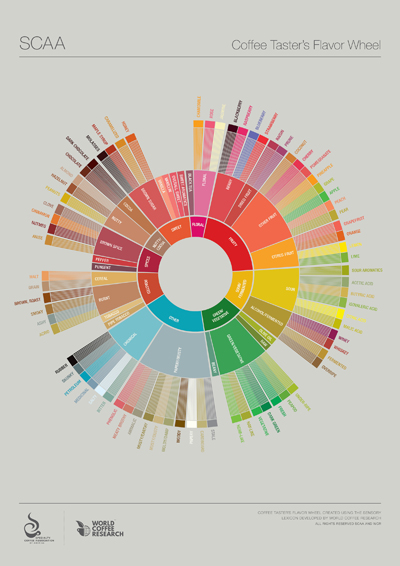
What exactly are the flavors to be found in coffee, besides… coffee? The SCA has created a guide, the flavor wheel, that presents the range of flavor profiles that coffee can exude. These can be exotic and exciting, like coconut, rose, and blueberry, or a sign that something has gone wrong, as in phenolic, animalic, or petroleum notes. Often, lighter roasts will embody lighter flavors, those floral and fruity, while a darker roast will take on tones of caramel, spice, and smoke. These subtle notes are the reason many people have been embracing the third wave.
As a city-dwelling millennial, I will lunge at any and all coffee available, downing any gas station’s Colombian blend, modifying my pumpkin spice latte, indulging in a seven-dollar espresso shot, or even settling for a host’s Keurig machine. I spoke with Devony Schmidt, a Harvard law student and coffee tourist, about what makes for good coffee.
“I started drinking and caring about coffee when I was in high school in Memphis,” Schmidt says. “During undergrad, I took a coffee cupping class on campus, and someone from the local roastery walked us through different flavor profiles.” A cupping class serves as an introduction to fine coffee for many aspiring connoisseurs. From there, a world of flavor awaits.
Schmidt has travelled all over the world drinking coffee — from Finland to Vietnam to Australia — and she is as picky as they come (“I have a hard time telling you a place in New York or Boston that I like to go for coffee”). We have both noticed a prevalence of third wave cafés across this country, in likely places like Denver or Austin, but more recently to be found in college towns and Midwestern cities as well. She says Starbucks was a good introduction to the broader world of coffee for the U.S., and it appears as though Americans might be ready for the complex — and sometimes expensive — implications of specialty coffee.
Good coffee starts with good beans. Like grapes and cacao, the flavor of coffee is influenced heavily by the soil and farming practices with which it is grown: its terroir. In recent years, single-origin beans — those sourced from a single growing region — have spiked in popularity. The terms “single-farm” and “single-estate” have even entered the language of consumers looking for a uniform taste. While most coffee is made from a blend that could feature beans from any number of locations, single-origin buyers know exactly where theirs is coming from.
Schmidt says that, in her experience, this makes all the difference: “If I’m making coffee for myself in the morning, I always drink a single-origin, because there’s one overwhelming flavor profile that really defines the coffee.”
Of course, what happens to the beans after they’re grown is just as important. This is where many so-called coffee snobs take issue with Starbucks. The roasting process determines much of the flavor of the resulting brew, and the Seattle chain is known for roasting its beans on the dark side, to put it lightly.
Third-wave coffeeists might savor the subtle — or glaring — differences in coffee flavor profiles, but for a chain café uniformity is the goal. That’s why Starbucks beans are heavily roasted — or burnt, as many coffee critics have claimed. A lighter roast will preserve the delicate characteristics of a coffee bean, while roasting it further gives it a bolder taste that can be replicated en masse. The dark, bitter coffee that the green mermaid churns out is also suited well to its milky, sugary drinks. The ones that have led millions to drink there in the first place.
The final steps that stand between farm and mug are grinding the beans and brewing them. Pre-ground coffee is a no-go for Schmidt and others like her. She extols the difference in quality that one can experience simply by opting for whole beans and grinding them to order. “The difference between fresh ground beans and pre-ground ones is huge!” she says. “Some coffee blogs will say you need a burr grinder (and you can get purer flavor with one), but if you’re just starting out, any normal electric grinder will do the trick.”
The coarseness of your grind will depend on which brewing method you’re using. These can range from a five-dollar plastic pour-over to an espresso machine priced in the tens of thousands. Of course, the latter isn’t necessary for an enhanced coffee experience. A French press, with coarse grounds, is perfect for making coffee for a group with more control over temperature and steeping time than a drip machine. Schmidt uses her trusty chemex each morning. Personally, I swear by the quick and transportable Aeropress that produces almost-espresso with fine grounds.
The move toward a more authentic relationship with coffee didn’t spring out of nowhere. Millennial culture has been known — and sometimes derided — for making mainstream the pursuit of adventurous and complex flavors in food and drink. Sriracha hot sauce is more prevalent than ketchup in many refrigerators, a double IPA may be preferred over a domestic lager, and pairings with the likes of fennel, truffle, and vanilla have never been gutsier. That the newest crop of adults would embrace a global coffee culture is hardly a surprise.
“For me, it became a good way to experience a city when I travel,” Schmidt says. “You can get a feel for a particular city or location by drinking their coffee, but you can also learn a lot about the world in general by learning about the coffee you’re drinking.” She cites the exciting coffee scenes of places like Myanmar and Melbourne. In the latter, you’d be hard-pressed to find a Starbucks amongst the thriving milieu of local Australian cafés.
Giuliano, of the Specialty Coffee Association, says their research indicates that Starbucks might be just fine here in the U.S., though. While people like specialty coffee because they perceive it to be better tasting, crafted by professionals, and more sustainable and ethical, they might not necessarily give up on Starbucks in making the switch. “People might get turned on to Neapolitan-style pizza, but that doesn’t they stop eating Domino’s,” he says. Giuliani’s data suggests that third-wave consumers often encountered gateways to specialty coffee in other shops, like Starbucks or Caribou, and they still return to those mainstays even after seeking out more refined coffee.
“We are in the middle of revolutionary period,” Guiliano says, noting the definite changes in the way Americans are drinking coffee. “There is a shift to people drinking better coffee, having more preference in regard to flavor, drinking in the afternoon, and even as a culinary indulgence.” These trends, however, don’t divert remarkably from Starbucks’ offerings. With their new Starbucks Reserve brand, the big box café is offering a wider variety of roasts and brewing methods at select stores. Even Folgers is attempting to jump on the bandwagon, with the release of their new 1850 series. Their light roast, called Lantern Glow, offers notes of “Lemongrass Jasmine Tea Top” and “Sweet, Lemony Undertones,” according to their website.
Schmidt is also skeptical that third-wave coffee can inflict the same damage on the chain in America. She believes that, for all their virtues, specialty coffee shops can seem overwhelming and elitist to casual consumers, and there could always be a place for a unicorn frappuccino in the U.S. market.
Schmidt and I inevitably turned the conversation to our Starbucks drinks-of-choice, when we are forced to suck it up and patronize the place, of course. She finds herself ordering a pumpkin spice latte about once a year, and I fondly reminisce over the discontinued 2016 drink, the Chile mocha. Neither of us takes the full four pumps of syrup that are standard. “I like to call myself an unsnobby coffee snob,” she says. “I also like good wine, but there’s a soft spot for the stuff that comes in a box.”
Vintage Ads: Coffee Talk
As the days grow shorter, we all need a little “oomph” to get the day going. These vintage coffee advertisements will put a little more pep in your step!
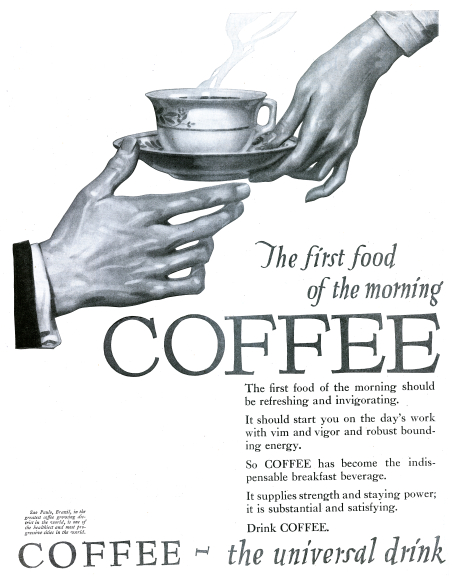
This ad from the Joint Coffee Trade Publicity Committee of the United States was a collaboration between the U.S. and Brazilian coffee growers. The campaign was run in 306 newspapers, 21 periodicals, 50 grocery-trade magazines, and nine medical journals, according to All About Coffee by William Harrison Ukers. The ads enumerated health benefits, provided directions on how to make it, encouraged groceries and restaurants to offer it, and offered recipes to expand its use as a flavoring agent.
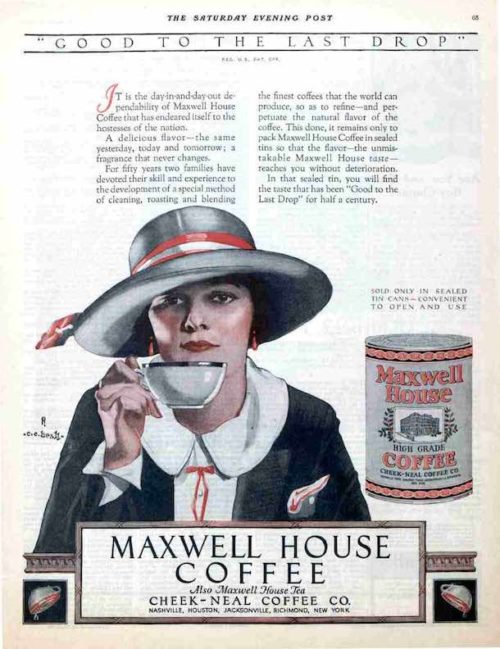
January 6, 1923
Maxwell House had already been selling coffee for 40 years when this ad appeared in 1923. The bestselling brand for decades, it was named after the Maxwell House Hotel in Nashville, Tennessee, which burned down in 1961.
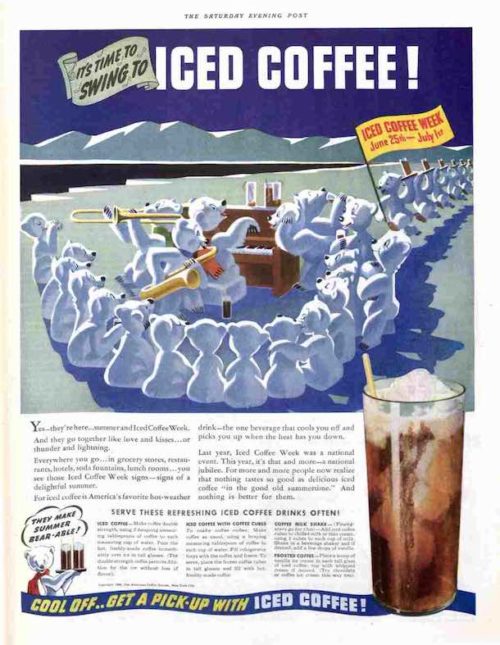
June 24, 1939
In an attempt to keep coffee sales flowing through the hot summer months, the Pan American Coffee Bureau created this marketing campaign around “Iced Coffee Week.” Who could resist these delicious recipes and adorable polar bears? Those of you sipping your salted caramel mocha Frappuccino can thank them.
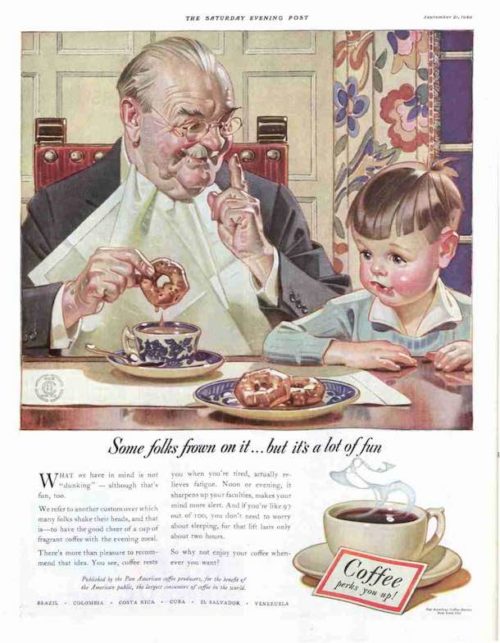
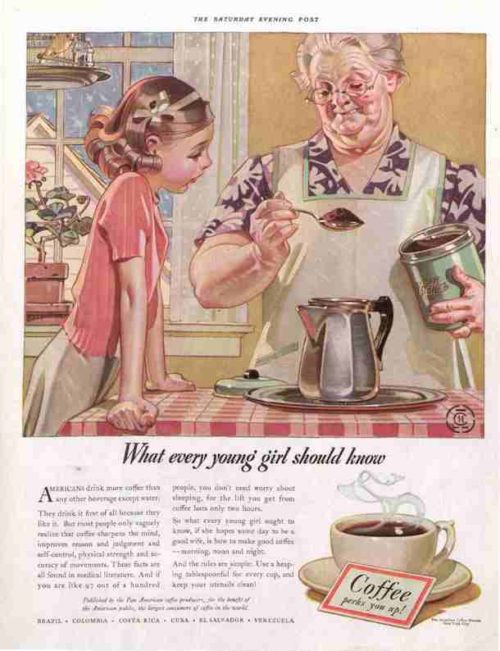
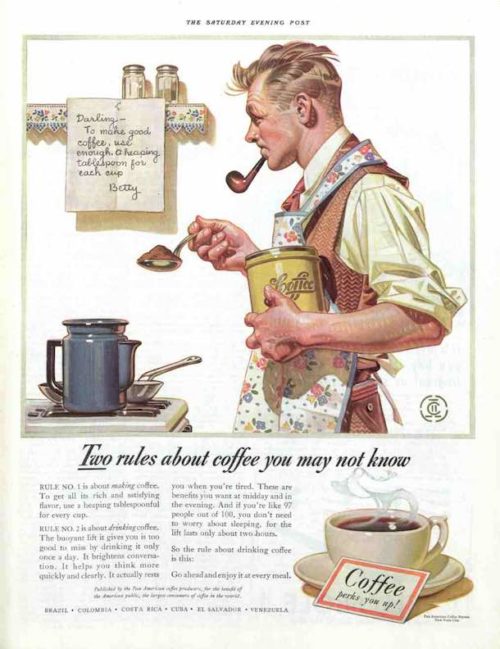
Not satisfied with expanding the coffee drinking into the summer months, the Pan American Coffee Bureau now encouraged folks to drink coffee all day long — at every meal, morning, noon, and night. Concerns over insomnia were poo-pooed, as the effects were guaranteed to last only two hours.
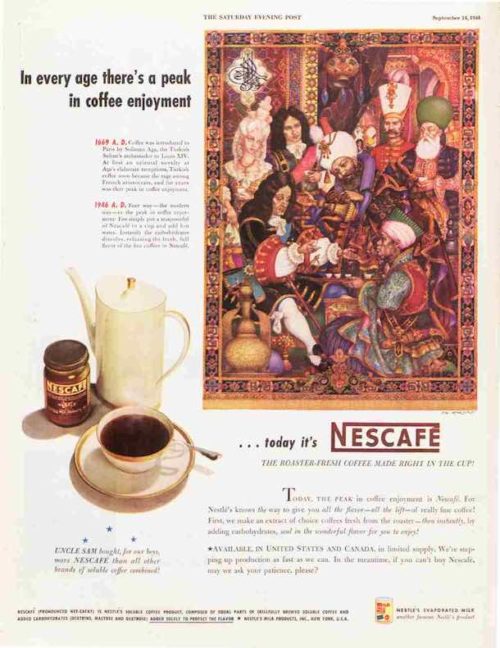
September 14, 1946
Developed in Switzerland in 1938 as a way to find a use for surplus coffee beans in Brazil, Nescafé started importing its instant coffee to the United States after the end of World War II. It had been a popular item in Army rations, so Nescafé had no trouble making the transition to American households. It was the perfect beverage for a nation craving convenience and modernity.
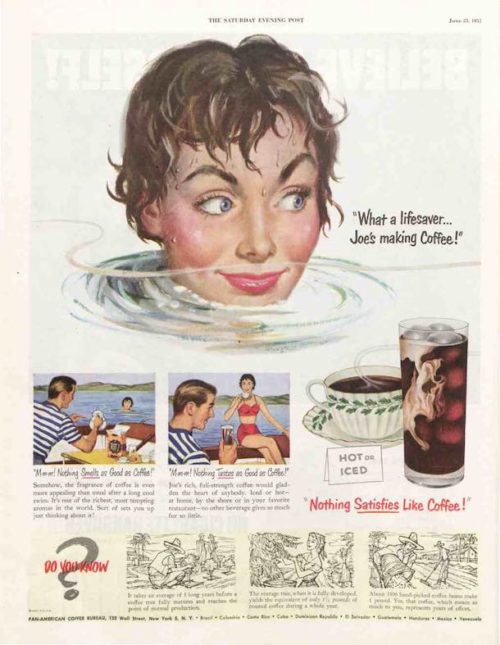
June 23, 1951
Once again, we hear from the Pan-American Coffee Bureau, touting a beverage so delicious it will lure maidens out of the lake. Ritz crackers made the perfect accompaniment.
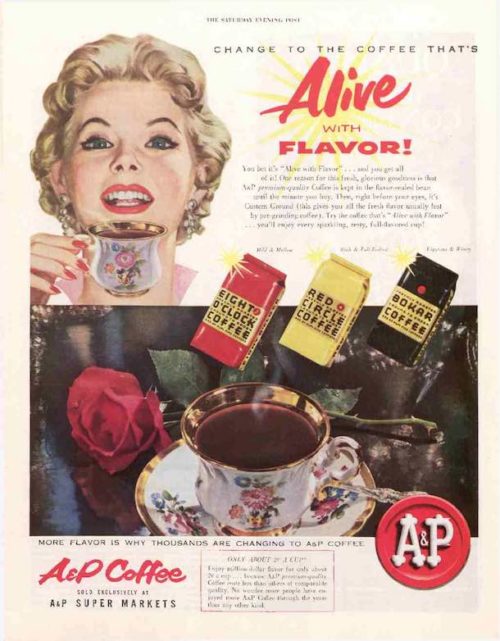
September 17, 1955
The Great Atlantic & Pacific Coffee and Tea Company (A&P) created Eight O’Clock Coffee in 1859. A&P promoted its economical price and the grocer’s offer to custom grind the beans right in the store. A&P sold the Eight O’Clock brand in 2003 (and the grocery chain closed its doors in 2015), but you can still buy the coffee in other stores.
Study: A Cup (or Six) of Coffee a Day May Keep Death at Bay
Are you an avid coffee drinker? Here’s something you can use as an argument every time someone warns you against drinking your third cup of coffee for the day: Coffee may actually add some years to your life.
A paper published recently in the New England Journal of Medicine details a study that began in 1995. A total of 402,260 test subjects (none of whom had heart disease or cancer) between the ages 50 and 71 were asked about their coffee drinking habits. Only 42,000 of all the test subjects were non-coffee drinkers, while most of them admitted to drinking two to three cups a day. A small number of subjects — 15,000 — said their daily coffee consumption usually reaches six cups.
By the time 2008 rolled in, 52,000 of the test subjects had already passed away. Based on the data gathered by the researchers, men who drank two to three cups of coffee daily were 10% less like to die, while it goes up to 13% for women. The percentage even reaches 16% for women who drink four to five cups a day.
According to the study, it doesn’t make a difference whether the coffee you drink is decaf or not — it’s not the caffeine that matters. Researchers haven’t been able to pinpoint the exact substance that benefits your health — it could be any one of coffee’s many components. It’s clear that more research is needed to establish the connection between drinking coffee and having a longer life, but Dr. Frank Hu of the Harvard School of Public Health believes it’s “the best evidence we have.”
Before you get up from your seat to get another cuppa, Dr. Hu has two pieces of advice for you. First, avoid cream and sugar and anything that could negate the health properties of coffee. Second, filter your coffee beans instead of boiling them, because filtering removes the components that can raise your cholesterol levels.
This story originally appeared on Tecca. More from Tecca:
41 tasty food and cooking resources to fill up on
Free iPhone app optimizes your caffeine intake, tells you when to put the coffee mug down
Tasty tech tips for brewing a great cup of coffee
Tasty Tech Tips for Brewing a Great Cup of Coffee
Cuppa joe, java, or “just give it to me and don’t talk” — whatever you call it, if you’re one of the millions of coffee drinkers worldwide, you know just how delightful a good cup of coffee can be. Many people think that making the perfect cup of coffee at home isn’t possible without a professional setup, but in this day and age, that isn’t as true as it used to be. If you stick to a few simple rules, you’ll be able to enjoy a superb mug of magic bean juice every time.
What is coffee, anyway?
The coffee beans that we see at the store are actually the roasted seeds from inside the fruit of a plant that is grown in many parts of Africa, South America, and Asia. There are a few different varieties of this coffee plant, which is why there are different types of coffee that you can buy at the store, each with their own unique differences in flavor. The two most common varieties are robusta, which is often the foundation for commercial coffee blends, and arabica, which is a bit more expensive and has a slightly sweeter, less bitter flavor.
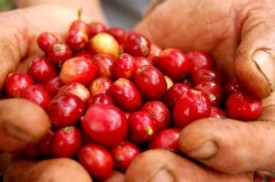
After the berries are harvested, the flesh is removed and the beans are dried. The beans (at this point called green beans) are roasted and ground to make the coffee that we know and love. For serious coffee connoisseurs, even the methods used to roast and grind the coffee matters!
Finding the perfect roast
There are three basic types of coffee roasts: light, medium, and dark. Different people prefer roasts for different reasons. Typically, dark roasts have a bolder, slightly sweeter flavor, while the light roasts tend to be a bit more acidic and aromatic (not to mention being very slightly higher in caffeine, typically). The important thing is to find a roast that tastes good to you.
After you determine which roast you prefer in general, try out a few different variations to fine tune what you like best. Most local coffee shops will be happy to help you find the right roast and style to fit your taste. A knowledgeable barista is like a good sommelier when it comes to finding a brew that suits your tastes.
Beans and grinders
The first step to brewing the perfect cup of coffee at home is to buy whole beans. Grinding up coffee beans releases oils. These oils can be lost if the coffee grounds are stored too long, yet they’re an important part of what makes a good cup of coffee. The oils add a whole new layer of flavor and complexity to the drink.
Buying whole beans means that you have to grind them before brewing. As any coffee aficionado will tell you, a good grinder is perhaps the most important part making good coffee. Having a consistent particle size makes a real difference in how coffee tastes, so you’ll probably want to play with your grinder to see what tastes best to you. Certain brewing methods also require a finer or coarser grind, so having a grinder that allows you to adjust this is also important to final quality.
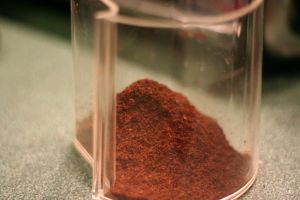
There are two basic types of grinders, burr and blade. Blade grinders are the cheapest and most common, consisting of a spinning blade that chops the beans. Unfortunately, blade grinders are notorious for having inconsistent grind coarseness. Unless you’re on a tight budget, avoid blade grinders for your coffee.
Burr grinders, usually more expensive than their blade counterparts, work by passing the beans through one or more sets of sharp grinding wheels to ensure a consistent particle size. A good burr grinder is an essential tool for any home barista. No matter which grinder you use, always grind your coffee immediately before brewing it to ensure that the grinds don’t dry out.
Brewing style
There are many different ways to brew your coffee, each with its own set of pros and cons. The most popular are pour-over, press pot, vacuum pot, and auto-drip.
- Pour-over: The pour-over style consists of a container with a hole in the bottom that holds a coffee filter over a cup or carafe. You simply place your grinds in the filter and pour the hot water slowly and evenly over all of the grinds.
- Press pot: The press pot (commonly called French press) method is another easy way to make a good cup of coffee. You do so by placing coarsely ground beans into the pot, then adding hot water. After waiting a few minutes (depending on taste), you press a filter/plunger down to separate the grounds. There’s a newer variation of this called the AeroPress, which works the same way but yields something more like espresso straight out of the press.
- Vacuum pot: Perhaps one of the coolest ways to brew your coffee, a vacuum pot works by placing ground coffee and water into two separate chambers. The water is then heated and, as it begins to boil, it’s sucked up into the chamber with the grinds. Turning off the heat brings the coffee (and not the grinds) back into the lower chamber. It’s impressive to watch and makes a great cup of coffee.
- Auto-drip: An auto-drip is a coffee maker that attempts to automate the pour-over method mentioned above. Most home coffee makers work this way. While it is definitely the most convenient method, it doesn’t necessarily brew the best cup of coffee possible due to less-than-ideal water temperature and poor grind saturation.
Brewing voodoo
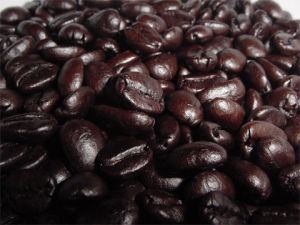
No matter which method you choose, there are a few tips to keep in mind. Typically, you want to use 1 to 2 tablespoons of ground coffee for every 6 ounces of water. Also, the quality of water you use makes a big difference in how the coffee tastes. If you have poor quality tap water, you may want to purchase a faucet filter or filtering pitcher, or maybe even consider getting bottled water service.
The temperature of the water can also make a big difference, as water that is too hot or too cool brews coffee differently. Ideally, the water should be just below boiling (around 200 degrees Fahrenheit). If you’re using a press pot or pour-over brewing method, the easiest way to make sure you have the ideal water temperature is to bring a kettle to a boil and then remove it from the heat briefly before pouring it evenly over your grounds, making sure to get all of them wet.
Ready… set… joe!
As you can see, making great coffee at home is surprisingly easy. Just remember:
- Buy whole beans.
- Use a burr grinder.
- Avoid auto-drip coffee makers.
- Watch your coffee-grounds-to-water ratio.
- Use good quality water at the proper temperature.
Pour yourself a cup, doctor it up how you like it best, and enjoy!
This story originally appeared on Tecca. More from Tecca:
41 tasty food and cooking resources to fill up on
The world’s tiniest coffee maker brews the world’s tiniest cuppa